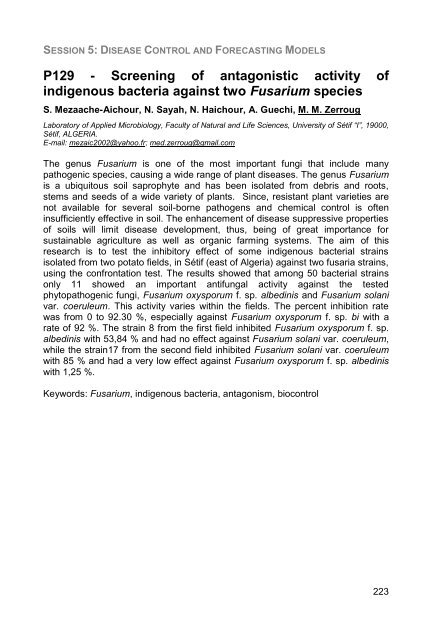EFS12- Book of abstracts - Contact
EFS12- Book of abstracts - Contact
EFS12- Book of abstracts - Contact
You also want an ePaper? Increase the reach of your titles
YUMPU automatically turns print PDFs into web optimized ePapers that Google loves.
SESSION 5: DISEASE CONTROL AND FORECASTING MODELS<br />
P129 - Screening <strong>of</strong> antagonistic activity <strong>of</strong><br />
indigenous bacteria against two Fusarium species<br />
S. Mezaache-Aichour, N. Sayah, N. Haichour, A. Guechi, M. M. Zerroug<br />
Laboratory <strong>of</strong> Applied Microbiology, Faculty <strong>of</strong> Natural and Life Sciences, University <strong>of</strong> Sétif “I”, 19000,<br />
Sétif, ALGERIA.<br />
E-mail: mezaic2002@yahoo.fr; med.zerroug@gmail.com<br />
The genus Fusarium is one <strong>of</strong> the most important fungi that include many<br />
pathogenic species, causing a wide range <strong>of</strong> plant diseases. The genus Fusarium<br />
is a ubiquitous soil saprophyte and has been isolated from debris and roots,<br />
stems and seeds <strong>of</strong> a wide variety <strong>of</strong> plants. Since, resistant plant varieties are<br />
not available for several soil-borne pathogens and chemical control is <strong>of</strong>ten<br />
insufficiently effective in soil. The enhancement <strong>of</strong> disease suppressive properties<br />
<strong>of</strong> soils will limit disease development, thus, being <strong>of</strong> great importance for<br />
sustainable agriculture as well as organic farming systems. The aim <strong>of</strong> this<br />
research is to test the inhibitory effect <strong>of</strong> some indigenous bacterial strains<br />
isolated from two potato fields, in Sétif (east <strong>of</strong> Algeria) against two fusaria strains,<br />
using the confrontation test. The results showed that among 50 bacterial strains<br />
only 11 showed an important antifungal activity against the tested<br />
phytopathogenic fungi, Fusarium oxysporum f. sp. albedinis and Fusarium solani<br />
var. coeruleum. This activity varies within the fields. The percent inhibition rate<br />
was from 0 to 92.30 %, especially against Fusarium oxysporum f. sp. bi with a<br />
rate <strong>of</strong> 92 %. The strain 8 from the first field inhibited Fusarium oxysporum f. sp.<br />
albedinis with 53,84 % and had no effect against Fusarium solani var. coeruleum,<br />
while the strain17 from the second field inhibited Fusarium solani var. coeruleum<br />
with 85 % and had a very low effect against Fusarium oxysporum f. sp. albedinis<br />
with 1,25 %.<br />
Keywords: Fusarium, indigenous bacteria, antagonism, biocontrol<br />
223
















![Présentation CRB-anim [Mode de compatibilité] - Inra](https://img.yumpu.com/17418636/1/190x135/presentation-crb-anim-mode-de-compatibilite-inra.jpg?quality=85)